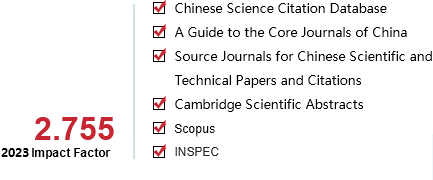[1]ZHENG Wenping,ZHANG Haojie,WANG Jie.Community detection algorithm based on dense subgraphs[J].CAAI Transactions on Intelligent Systems,2016,11(3):426-432.[doi:10.11992/tis.201603045]
Copy
Community detection algorithm based on dense subgraphs
CAAI Transactions on Intelligent Systems[ISSN 1673-4785/CN 23-1538/TP] Volume:
11
Number of periods:
2016 3
Page number:
426-432
Column:
学术论文—机器学习
Public date:
2016-06-25
- Title:
- Community detection algorithm based on dense subgraphs
- Keywords:
- complex network; community detection; graph clustering; soft clustering; density; core extended strategy; vertex betweenness; modularity
- CLC:
- TP18
- DOI:
- 10.11992/tis.201603045
- Abstract:
- The density-based graph clustering algorithm has been widely used in community detection. However, because it identifies a community by searching a partially dense subgraph in the network, many nodes do not constitute a dense subgraph and are therefore difficult to cluster. In this paper, we present a soft clustering algorithm based on dense subgraphs (BDSG) for detecting communities in complex networks. First, we propose a method for detecting the central communities. Next, we define the degree of community attribution of a node, and put forward a core community extended strategy. Finally, we obtain the clustering results of a network. Compared with the clique percolation method (CPM), k-dense algorithms from Zachary’s Karate Club, the dolphin social network, the American college football network, the email network, and the collaboration network, BDSG shows considerably better performance with respect to modularity and time efficiency. In addition, the proposed core community extended strategy may improve the effectiveness of the clustering-methods-based density, such as that in CPM, k-dense algorithms, and others.
- References:
-
[1] FORTUNATO S. Community detection in graphs[J]. Physics reports, 2010, 486(3/4/5): 75-174.
[2] NEPUSZ T, YU Haiyuan, PACCANARO A. Detecting overlapping protein complexes in protein-protein interaction networks[J]. Nature methods, 2012, 9(5): 471-472.
[3] DEYLAMI H A, ASADPOUR M. Link prediction in social networks using hierarchical community detection[C]//Proceedings of the 7th conference on information and knowledge technology. Urmia, Iran, 2015: 1-5.
[4] SCHAEFFER S E. Graph clustering[J]. Computer science review, 2007, 1(1): 27-64.
[5] 杨博, 刘大有, LIU Jiming, 等. 复杂网络聚类方法[J]. 软件学报, 2009, 20(1): 54-66. YANG Bo, LIU Dayou, LIU Jiming, et al. Complex network clustering algorithms[J]. Journal of software, 2009, 20(1): 54-66.
[6] 冀俊忠, 刘志军, 刘红欣, 等. 蛋白质相互作用网络功能模块检测的研究综述[J]. 自动化学报, 2014, 40(4): 577-593. JI Junzhong, LIU Zhijun, LIU Hongxin, et al. An overview of research on functional module detection for protein-protein interaction networks[J]. Acta automatica sinica, 2014, 40(4): 577-593.
[7] PALLA G, BARABáSI A L, VICSEK T. Quantifying social group evolution[J]. Nature, 2007, 446(7136): 664-667.
[8] SIDIROPOULOS A, PALLIS G, KATSAROS D, et al. Prefetching in content distribution networks via web communities identification and outsourcing[J]. World wide web, 2008, 11(1): 39-70.
[9] 陈克寒, 韩盼盼, 吴健. 基于用户聚类的异构社交网络推荐算法[J]. 计算机学报, 2013, 36(2): 349-359. CHEN Kehan, HAN Panpan, WU Jian. User clustering based social network recommendation[J]. Chinese journal of computers, 2013, 36(2): 349-359.
[10] FREY B J, DUECK D. Clustering by passing messages between data points[J]. Science, 2007, 315(5814): 972-976.
[11] NEWMAN M E J. Community detection and graph partitioning[J]. Europhysics letters, 2013, 103(2): 28003.
[12] NEWMAN M E J. Spectral methods for community detection and graph partitioning[J]. Physical review E, 2013, 88(4): 042822.
[13] LIN Chuncheng, KANG Jiarong, CHEN J Y. An integer programming approach and visual analysis for detecting hierarchical community structures in social networks[J]. Information sciences, 2015, 299: 296-311.
[14] REN Jun, WANG Jianxin, LI Min, et al. Identifying protein complexes based on density and modularity in protein-protein interaction network[J]. BMC systems biology, 2013, 7(S4): S12.
[15] LI Xiaoli, FOO C S, NG S K. Discovering protein complexes in dense reliable neighborhoods of protein interaction networks[C]//Proceedings of the computational systems bioinformatics conference. San Diego, USA, 2007, 6: 157-168.
[16] PALLA G, DERéNYI I, FARKAS I, et al. Uncovering the overlapping community structure of complex networks in nature and society[J]. Nature, 2005, 435: 814-818.
[17] SAITO K, YAMADA T, KAZAMA K. Extracting communities from complex networks by the k-dense method[J]. IEICE transactions on fundamentals of electronics, communications and computer sciences, 2008, E91-A(11): 3304-3311.
[18] SUN Penggang, GAO Lin. Fast algorithms for detecting overlapping functional modules in protein-protein interaction networks[C]//Proceedings of the IEEE computational intelligence in bioinformatics and computational biology. Nashville, TN, USA, 2009: 247-254.
[19] LIU Guimei, WONG L, CHUA H N. Complex discovery from weighted PPI networks[J]. Bioinformatics, 2009, 25(15): 1891-1897.
[20] BADER G D, HOGUE C W V. An automated method for finding molecular complexes in large protein interaction networks[J]. BMC bioinformatics, 2003, 4(1): 2.
[21] FREEMAN L C. A set of measures of centrality based on betweenness[J]. Sociometry, 1977, 40(1): 35-41.
[22] CUI Yaizu, WANG Xingyuan, EUSTACE J. Detecting community structure via the maximal sub-graphs and belonging degrees in complex networks[J]. Physica A: statistical mechanics and its applications, 2014, 416: 198-207.
[23] ZACHARY W W. An information flow model for conflict and fission in small groups[J]. Journal of anthropological research, 1977, 33(4): 452-473.
[24] LUSSEAU D, SCHNEIDER K, BOISSEAU O J, et al. The bottlenose dolphin community of Doubtful Sound features a large proportion of long-lasting associations: Can geographic isolation explain this unique trait[J]. Behavioral ecology and sociobiology, 2003, 54(4): 396-405.
[25] NEWMAN M E J. Finding community structure in networks using the eigenvectors of matrices[J]. Physical review E, 2006, 74(3): 036104.
[26] GUIMERà R, DANON L, DíAZ-GUILERA A, et al. Self-similar community structure in a network of human interactions[J]. Physical review E, 2003, 68(6): 065103.
[27] NEWMAN M E J, GIRVAN M. Finding and evaluating community structure in networks[J]. Physical review E, 2004, 69(2): 026113.
[28] SHEN Huawei, CHENG Xueqi, CAI Kai, et al. Detect overlapping and hierarchical community structure in networks[J]. Physica A: statistical mechanics and its applications, 2009, 388(8): 1706-1712.
- Similar References:
Memo
-
Last Update:
1900-01-01
